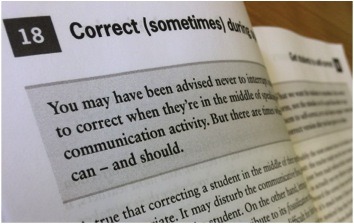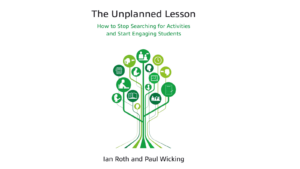I received a small package from Cambridge University Press last week and was eager to open it up and see what I had received. Sure enough, as I was expecting, my new copy of “Penny Ur’s 100 Teaching Tips” had swiftly been delivered. My first reaction was, “wow such a small book” and then I started to look at it in more detail. I instantly realised that this book is not meant to focus extensively on English language teaching, but is solely a practical source of information for teachers in various areas of teaching. We already, for example, have books which focus on Classroom Management Techniques or lesson planning, and it is refreshing to read a book which cuts down on the waffle and offers readers practical and clear ideas to incorporate in class. Penny Ur has authored or co-authored many practical books before such as “Vocabulary Activities”, “Five Minute Activities”, “Teaching Listening Comprehension” as well as “Discussions that Work”. Incidentally, my favourite book in my early years of teaching was “Five Minute Activities” and there were so many practical ideas which I incorporated into my teaching. Nonetheless, let’s have a look at her latest publication.
The book is split between 21 chapters – these including the Introduction and Index – and cover a range of areas of teaching. Penny Ur’s introduction explains why she wrote the book, covers a little of her teaching career and inspires the reader to continue on. There are a lot of sub-chapters from the remaining 19 chapters and the Index allows the reader to easily find an area of teaching, such as error correction, picture dictation or speaking, easily accessible. These chapters are organised into the following:
| Beginning and ending the lesson
The Coursebook Discipline Error correction Games Grammar Group work Heterogeneous classes Homework Interest |
Listening Pronunciation Reading comprehension Speaking activities Teacher talk Testing and assessment Vocabulary teaching Writing P.S. |
Each of the chapters, which offers the reader the opportunity to make an educated guess on the topic to read, has between four to seven teaching tips apart from the final chapter, ‘P.S.’. The author has written the book in such a way that teachers do not have to read it from cover-to-cover. Readers can decide on a topic and then get some inspiration from a particular area of teaching. For example, if you are interested in the area of teacher talking time, you could look at the contents list and refer to the 6 sub-chapters related to the chapter on ‘Teacher Talk’. These topics sub-chapters include:
- Talk a lot
- Keep eye contact
- Tell stories
- Teach common classroom language
- Use mother tongue occasionally
- Invite short responses

Should you decide to read more about telling stories, you can go to the relevant page. Each sub-chapter has a page worth of teaching tips, therefore there are 100 pages of teaching tips within this book. Each teaching tip is easy to digest as there is not too much information on the page with a suitable sub-heading which encapsulates the topic effectively. For example on the subchapter on ‘Tell stories’, there is inspiring piece of sub-heading:
“One excellent way of exposing students to spoken English through teacher talk is storytelling – not only for young learners.” (p.94)
Further down the page there is additional teaching tips and techniques which the reader could easily incorporate into their own classes, such as using a picture-book with young learners to tell a story, using online video versions to support your story, as well as using jokes or other strange events to support the telling of stories and also keep students’ attention. This is one example from the many practical ideas within “Penny Ur’s 100 Teaching Tips”. All tips are broken down into an easy-to-read format and inspires the reader an opportunity to incorporate these invaluable ideas.
The major advantage to this book is that it is also downloadable as well as being available in paperback. The digital formats available include Apple iBook, Google ebook, Kindle ebook and an eBooks.com ebook. So if you wish to purchase this but are unable to purchase a paperback copy, you can purchase it in a digital format. It is not going to be a thorough book on all aspects of English language teaching as this is not what it is focused on. It is a book on the areas of teaching which are more pertinent to teachers and offers a number of ideas which readers could use or tweak if they should wish. As Penny Ur mentioned in her introduction, readers should not “regard [the teaching tips] as directives from an authority, but as suggestions from a colleague” (p.viii). The reader is encouraged to use the tips and techniques selectively.
Actually, this book reminds me of the teaching tips nearer the back of Jim Scrivener’s “Learning Teaching” where there were a number of recommendations for teachers to consider on all aspects of language teaching. I was so inspired by some of these statements by Scrivener that I typed them up on a computer, printed them out, cut these up and laminated them. These self-made flashcards are with me to remind about teaching which can so easily be forgotten. But I am also pleased to say that the book will also be with me so that I am able to get ideas for teaching.
I recommend “Penny Ur’s 100 Teaching Tips” for any English teacher as this book is a wonderful reference book for those seeking a quick technique with regards to an area of teaching. I can see teachers referring to this book if there class observation highlights a few areas to focus on for next time.
There are more resources available for those wishing to learn more about Penny Ur’s latest publication here:
- Penny Ur’s 100 Teaching Tips for English (Part 1): Video Link
- Penny Ur’s 100 Teaching Tips for English (Part 2): Video Link





One Response
Jamie Clayton
Cheers for the review, great to see another useful elt book available in digital format.
08/11/2016